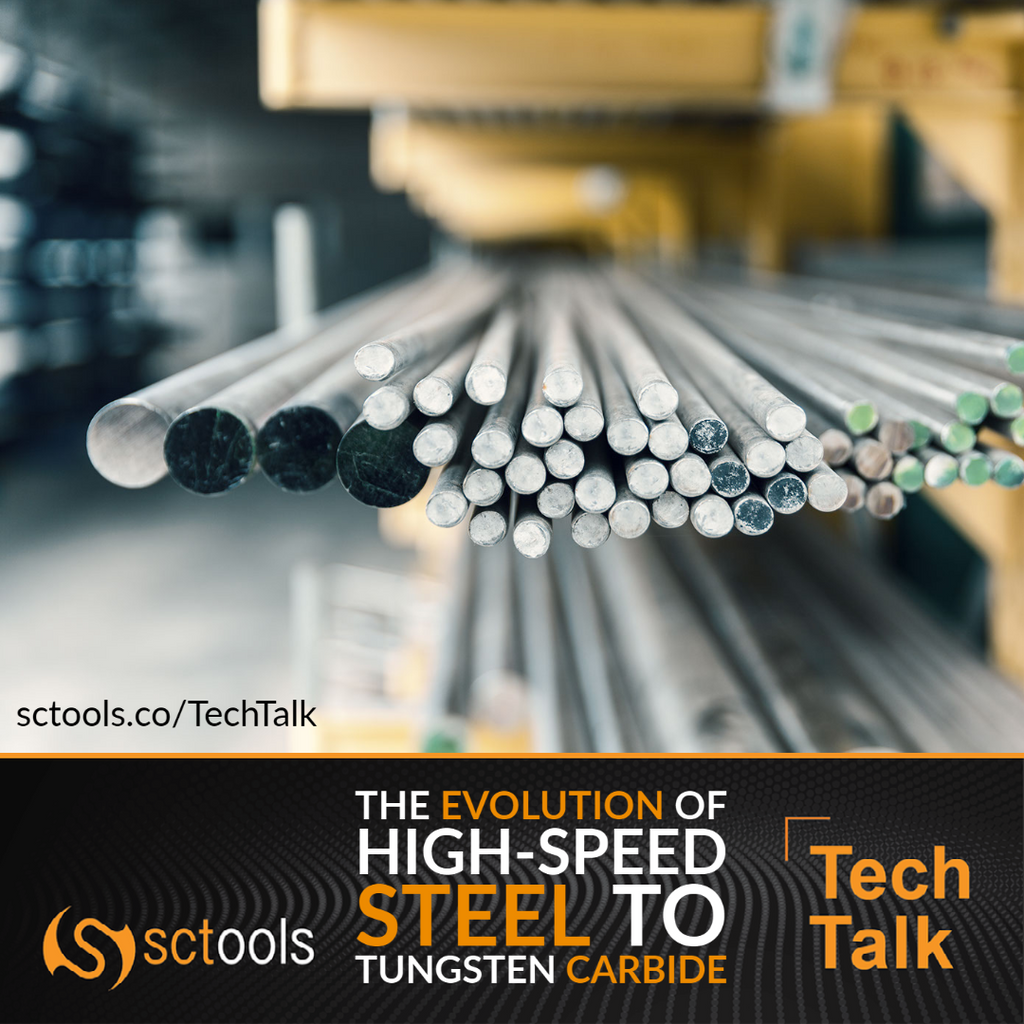.
TechTalk
"If it does not challenge you, it wont change you" - Unknown
The Evolution of High-Speed Steel To Tungsten Carbide
The History of Tool Bits
Initially, high carbon tool steels were used to make all tool bits. Appropriate hardening and tempering were necessary to ensure that these bits were built to last. However, since the 1930s, new products have been developed to replace such steels and manufacture tool bits more efficiently. Today, most tools are made of carbide. These changes in products have allowed for revolutionary improvements in the machining and manufacturing industries.
Materials That Replaced Carbon Steel
- Sintered Carbide
- Ceramics
- Diamond Cutters
What Is Tungsten Carbide?
To make Tungsten Carbide (WC) chemical compounds is necessary to have equal parts of tungsten and carbon atoms. If you were to look at tungsten carbide in its most basic form, you would see a fine gray powder. This gray powder can be pressed and molded into shapes through a sintering process. Tungsten Carbide is almost twice as stiff as steel and possesses double the density. To polish or finish carbide, it is necessary to use abrasives with stronger hardness, such as grinding wheels, compounds, or diamond powder.
Carbide steel is made up of carbon and at least one other metallic alloy element. Carbide is extremely fragile when it is not paired with another metallic alloy. The introduction of carbide steel has allowed for harder metals to be machined, which has increased the ability to expand metal production. This expansion has led to better tools that are built to last and unique architectural designs that could not be achieved otherwise.
What Products Are Made Of Tungsten Carbide?
- Cutting tools
- Armor-piercing shells
- Jewelry
- Abrasives
- Industrial machinery
What Is High-Speed Steel?
An alloy is a combination of two or more metallic elements. Alloys are needed to manufacture high-speed steel. These compositions are either a solution or a compound made of steel and iron (ferrous). Carbon steel was commonly used in the early 1900s. However, high-speed steel became far more popular due to its ability to maintain its shape when put under a strain from high heat created from friction.
What Is Sintering?
Sintering occurs when one uses heat and pressure to fuse particles into one solid mass without melting the materials. The purpose of this process is to strengthen and improve the structural integrity of the material. Powders convert into metals through the sintering process.
Why Is Tungsten Carbide Powder Added To High-Speed Steel?
When Tungsten carbide powder gets added to high-speed steel, the metal becomes tougher and can handle higher temperatures. Such a process is typical when manufacturing steels used for hot forming. Tools made of carbide cut steel faster and last longer than tools made of metals without carbide.
Why Are High-Speed Steel Products Still Popular?
High-speed steel products are a lot cheaper than Tungsten Carbide products. Many individuals will still choose a carbide product even though a carbide tool will outlast a high-speed steel tool. High-speed steel products are great for applications that are low-volume and high-mix.
High-speed steel products are durable. However, the product needs to be replaced more
frequently and will slow the cutting or drilling process down.
Essential Factors To Consider When Choosing Quality Tools
- Carbide can be used to cut all metals because it is the most robust metal (chemical
- composition)
- High-speed steel is durable but tends to break down faster
- High-speed steel products are cheaper than Carbide tools
- A weak metal can not cut through a hard metal because the two metals will fuse
The History of High-Speed Steel To Tungsten Carbide
High-speed steel metal was the primary steel that was used to manufacture tools in the early The 1900s. However, WWII created an issue where materials became extremely expensive and were hard to find. This setback required developing a solution that would allow the production of materials such as bolts, screws, and tool bits.

Which Tool Is Best For The Job?
One must consider many factors when deciding which tool is best for a job, such as:
- How deep does the cut need to be?
- How much material needs to be removed?
- What is the cycle time?
- How much does the tool cost, and how often will it need to be replaced?
- What size tool do you need?
These are just a few questions to consider when deciding which tool is best for any job. If you are willing to change your bit frequently, then cost shouldn't matter as much when it comes to the tools that you purchase. However, if you are looking for a quality tool that will last, the tungsten carbide tool is the correct choice.
By analyzing the evolution of high-speed steel to tungsten carbide, it is easy to see that altering one material's composition can create a more robust and more durable product.

If you have any questions about carbide cutting tools, be sure to reach out to us @ sctools.co/Home or call us at (877)737-0987. We help you machine better!


Comments (0)